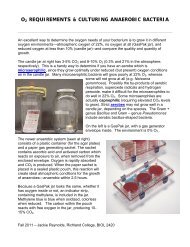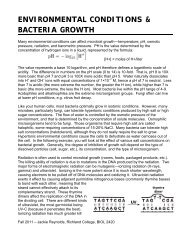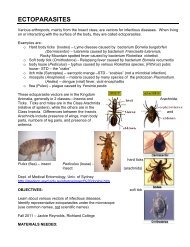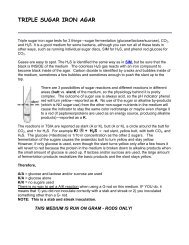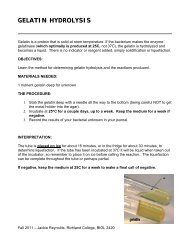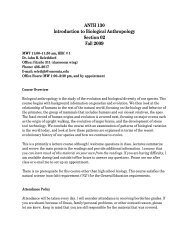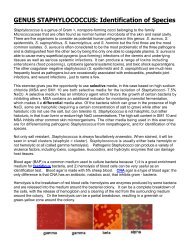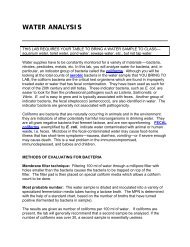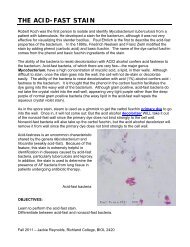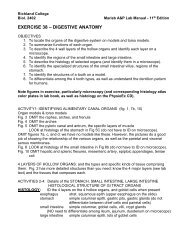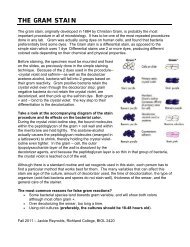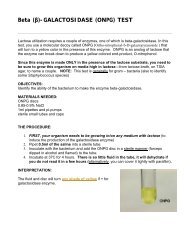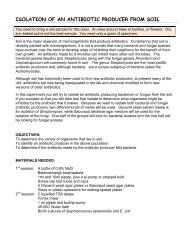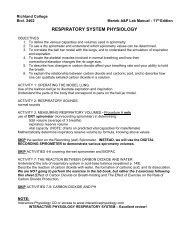API Test Strips
API Test Strips
API Test Strips
Create successful ePaper yourself
Turn your PDF publications into a flip-book with our unique Google optimized e-Paper software.
<strong>API</strong> 20EThis <strong>API</strong>-20E test strip (from bioMerieux, Inc.) is used to identify the enteric gram negativerods (although <strong>API</strong> makes a variety of other test strips for yeast, Staph, anaerobes, etc.) 20separate test compartments are on the strip, all dehydrated. A bacterial suspension is used torehydrate each of the wells. Some of the wells will have color changes due to pH differences:others produce end products that have to be identified with reagents. A profile number isdetermined from the sequence of + and - test results, then looked up in a codebook having acorrelation between numbers and bacterial species.OBJECTIVE:Learn how to perform and interpret the miniaturized, multi-test technique for bacterialidentification.MATERIALS NEEDED:agar plates of bacterial species0.85% NaCl solutions (5ml)sterile Pasteur pipettes + bulbssterile mineral oil<strong>API</strong> 20E test strip (for oxidase - gram negative rods)<strong>API</strong> test strip incubation chamber AFTER INCUBATION: 10% FeCl3, Barrett's reagents Aand B, Kovac's reagentPROCEDURE:Prepare a suspension of the bacteria in the saline tube1. Inoculate a large colony (2-3mm diameter)of the bacterium (pure culture) into the0.85% NaCl solution, making sure that the suspension ishomogenous and without clumps of floating bacteria.2. Use a McFarland barium sulfate standard #3 to quantitate thesuspension and to produce a standard inoculums size..Inoculate the <strong>API</strong> strip1. Holding the strip at a slight angle up from the table top, you willnow inoculate the bacterial suspension into each well with thesterile pipette.
2. Touch the end of the pipette to the side of the cupule,allowing capillary action to draw the fluid into the well asyou slowly squeeze the bulb. This should eliminate anybubbles forming in the wells. Each well should be filledup to the neck (see diagram).3. CIT, VP, and GEL have boxes around their names.These test wells will be filled all the way up to the top ofthe well.4. LDC, ODC, ADH, H 2 S, and URE are filled as describedin step B, but they will then be filled up to the top withsterile mineral oil.Incubate the strip in its chamber1. The bottom of the incubation chamber has small indented wells in the bottom: fill it withwater just enough to fill these indentations.2. Place the strip into this bottom. There should not be so much water that it slops ontothe <strong>API</strong> strip.3. Place the top of the incubation chamber over the bottom, and label it.4. Place the strip at 37 o C for 18-24 hours.INTERPRETATION:1. Add the proper reagents to thecompartments:o 1 drop of Kovac's to the IND (read withina couple of minutes)o 1 drop of Barritt's A and B to VP (a +reaction may take up to 10 minutes)o 1 drop of FeCl3 to TDA2. Read all other tests as described (chart below) without reagents using the tablebelow..3. Record results on the diagram handed out to you in lab. The oxidase test reactionshould be negative, and is added as the last test result.4. Take your result sheet to the computer to INPUT YOUR REACTIONS: The <strong>API</strong> 20Ewebsite database will provide you with potential organisms.A more specific 9-digit number can be obtained with a fewmore tests:, but NOT DURING THIS LAB.(pictures from the <strong>API</strong> 20E documentation, from BioMerieux)
READING THE <strong>API</strong> 20TESTS SUBSTRATE REACTION TESTED - RESULTS + RESULTSONPG ONPG beta-galactosidase colorless yellowADH arginine arginine dihydrolase yellow red/orangeLDC lysine lysine decarboxylase yellow red/orangeODC ornithine ornithine decarboxylase yellow red/orangeCIT citrate citrate utilization pale green/yellow blue-green/blueH2S Na thiosulfate H2S production colorless/gray black depositURE urea urea hydrolysis yellow red/orangeTDA tryptophan deaminase yellow brown-redIND tryptophan indole production yellow red (2 min.)VP Na pyruvate acetoin production colorless pink/red (10 min.)GEL charcoal gelatin gelatinase no diffusion of black black diffuseGLU glucose fermentation/oxidation blue/blue-green yellowMAN mannitol fermentation/oxidation blue/blue-green yellowINO inositol fermentation/oxidation blue/blue-green yellowSOR sorbitol fermentation/oxidation blue/blue-green yellowRHA rhamnose fermentation/oxidation blue/blue-green yellowSAC sucrose fermentation/oxidation blue/blue-green yellowMEL melibiose fermentation/oxidation blue/blue-green yellowAMY amygdalin fermentation/oxidation blue/blue-green yellowARA arabinose fermentation/oxidation blue/blue-green yellowOX oxidase oxidase colorless/yellow violetQUESTIONS:1. What is the purpose of the water in the tray?2. What is the function of the mineral oil?3. What are the advantages of this test (compared to regular biochemical tube media)?4. What are the disadvantages of this test?8/2009, Jackie Reynolds, Richland CollegeLAB MANUAL: TABLE OF CONTENTS



